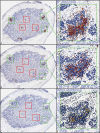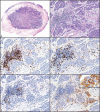High expression of PD-1 and PD-L1 in ocular adnexal sebaceous carcinoma
- PMID: 30228943
- PMCID: PMC6140585
- DOI: 10.1080/2162402X.2018.1475874
High expression of PD-1 and PD-L1 in ocular adnexal sebaceous carcinoma
Abstract
Ocular adnexal sebaceous carcinoma (OASC) is an aggressive malignancy that frequently recurs locally and metastasizes. Surgical extirpation may produce significant aesthetic morbidity, and effective systemic therapies for locally advanced or metastatic disease are largely ineffective. Immune checkpoint inhibitors have shown efficacy in the management of several solid tumors where tumor cell PD-L1 expression correlates with improved response. To determine whether OASC might be amenable to immune checkpoint blockade, we performed comprehensive immune profiling for CD3, CD8, PD-1, FOXP3, and PD-L1 in 24 patients with primary OASC. The composition, distribution and density of the tumor associated immune infiltrate were quantified by automated image analysis and correlated with measures of clinical outcome. Tumor cells in 12 OASCs (50%) expressed PD-L1. Higher densities of CD3+ (p = 0.01), CD8+ (p = 0.006), and PD-1+ (p = 0.024) tumor-associated T cells were associated with higher T category (≥T3a per the 7th edition of the American Joint Committee on Cancer staging manual). Higher tumor cell expression of PD-L1 correlated with higher density of PD-1+ tumor-associated T cells (p = 0.021). Since a CD3+ CD8+ PD-1 + T-cell infiltrate represents a "suppressed T-cell phenotype" apparently permissive toward OASC progression, our findings provide a mechanistic rationale for the effective application of immune checkpoint blockade in OASC to abrogate PD-1/PD-L1 interaction and effectively unleash the immune infiltrate to treat higher-stage tumors.
Keywords: PD-1; PD-L1; Sebaceous; biomarkers; carcinoma; immunosurveillance; inflammation and cancer; ocular.
Figures


References
LinkOut - more resources
Full Text Sources
Other Literature Sources
Research Materials
